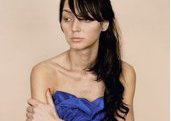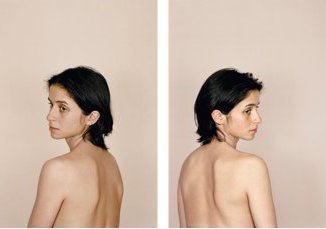
Sarah’s photographic practice has examined the consulting space used for psychoanalysis, in particular ‘the couch’ as subject.
Sarah studied Fine Art at Goldsmith’s College, London, completing her Master’s in 1996 and her first degree in Fine Art and Contemporary Dance in 1981. Her work has been exhibited internationally in both museums and galleries and is represented in many major public and private collections. These include: Tate, The Victoria & Albert Museum, Arts Council of England, The National Media Museum, The Government Collection (UK), Museum Folkwang Essen, Galeria Civica, Modena, FRAC Nord-Pas de Calais, Orange County Museum of Art, and Museum of Modern Art, San Fransisco. She is represented by Maureen Paley London, and Anton Kern Gallery, New York. A monograph on her work was published by Violette Editions in October 2013.
Key details
School, Centre or Area
Gallery
More information
Research interests
Sarah’s recent research is concerned with questions such as: how does the view camera picture and mirror? How does this relate to notions of perception? Does the photograph return experience in a double bind? How might we read the photograph that slides between the documentary and the fictional? How does affect, versus the photograph as being hermetic, determine our reading?
Her work examines intellect versus the visceral, the nature of ‘photographic black’, of darkness, and the reduction of the illusion of spatial depth along with an approximation of life size.
Practice
Sarah’s practice critically engages with specific areas of contemporary experience. Her work is predicated on a representation of the authentic and the vernacular and, in particular, the view the camera transcribes. Ongoing themes include: how we might engage with images of the consulting space for psychoanalysis; the domestic intimate space versus nature in a familiar urban context; the portrait (of the singular female); hair as a motif; and, most recently, the artist’s studio; the life-drawing room; the life model; and ‘the horse’.
Sarah’s photographs establish a vocabulary suggested both by the subject pictured and how that subject is pictured, and draw on how certain themes continue to be present in the collective imagination. The themes of her work have developed over many years, and the nature of her practice is such that her work often re-visits and refers to core concerns. In this way subject headings act as chapters that reference and cross-reference each other, and establishes discourses across her work and in relationship to current debates in photography.
Sarah’s photographs are made on a large format camera on location. As well as figuring people who have a relationship to that location, images of both the interior and the exterior are often characterised by a combination of both available daylight and directional studio lighting. A blurring of the illusion of ‘night and day’ raises the question of how an aesthetic contributes to our reading of, alongside an imagining regarding, the photograph. A concern for ‘frontality’ and formal composition, and how scale when viewed in the gallery is related to scale of subject previously in front of the camera, further characterises her practice.
Current and recent projects
Horse?
This current research, a development of recent work, re-examines the art historical classical subject of ‘the horse’. In particular a display horse, highly groomed and accustomed to being looked at. Working on a 10 x 8 camera this black horse is pictured in front of a photographic black backdrop. The subject both rotates around a central point and across a left and right plane in front of the static camera. These photographs further develop concerns such as perception and viewing/imagined space, as well as the notion of surface – the coat of the horse versus the deadened surface of the photograph. This work additionally addresses the nature of the physical presence of ‘the horse’ and the attempts to articulate this versus the impossibility of transcribing such and of inscribing fully in a photograph proximity to otherness.
Mirror/Excess (2010–)
This project’s starting point was a photograph by Fox Talbot (1840) of a handwritten stanza by Byron and Mark Haworth Booth’s text in the V&A publication Things. Talbot’s 10 x 8 contact print of Byron’s writing transcribed in reverse suggests both a viewing from an imagined space behind along with in front of the image. Jones’ work takes ‘the life model’ as its theme; a classical subject associated with drawing from life and from a singular and many viewpoints, and which also suggests both the private and public individual. How might a photograph inscribe the nature of an extended moment of looking and a circular movement around a subject? In these diptychs the life model is both seen and unable to see her self. How do we look and who are we looking at? How do methods of measuring, scale and light affect the image, and its viewing? Does something nonetheless escape this structure when engaging with the photographic portrait?
New Work (2008)
This developed out of research commenced during Jones’s tenure as Photography Fellow (2006/7) at The National Media Museum, and references early stereoscopic photographs by Claudet. Taking the singular subject of a rose plant in rose garden displays in urban parks, isolating the subject against black and blurring night and day by the use of studio lights on location these diptychs re-examine the genre of still life. Views made around a constant pivotal point split ‘front and back’ across left to right. These Rochsarch test-like diptychs address how imagination might inform our experience of a photograph and how at odds this often is with how the camera records, how an imagined space might exist outside and around the photograph and how the aesthetic and scale of an image affects our engagement.
Publications, exhibitions, other outcomes
Recent solo exhibitions
Minneapolis Institute of Arts, USA (2013); Maureen Paley Gallery, London (2008); The National Media Museum (2007), the conclusion of Jone’ 18-month tenure as the Museum's Photography Fellow; Anton Kern Gallery, New York (2006–7).
Recent group shows
(2012) Seduced by Art: Photography Past and Present, National Gallery, London and on tour to La Caixa Forum Barcelona and La Caixa Forum Madrid; Family Matters: The Family in British Art, Tate Britain; Melancholia, Villa Kliinger, Leipzig; Der Mensch und Seine Objekte, Museum Folkwang, Essen; Observers: Photographers of the British scene from 1930s to Now, Galeria de arte do sesi, Sao Paulo
(2011) Heroines, Museo Thyssen-Bornemisza & Fondacion Caja, Madrid; Stripped (Tate Visual Dialogues), Nottingham Castle Museum; Dutch Still Life, Peabody Essex Museum, Massachussets, USA; Streetlife And Home Stories - Fotografien aus der Sammling Goetz, Museum Viilla Stuck
(2010) Peeping Tom (curated by Keith Coventry), Vegas Gallery, London; Photograph(e)s Musee Nicephone Niepce, Musee de la Photographie, France
(2009) The Casini Cruise, Ardi Poels Projects, Maastricht Flower Power, Villa Giuila-CRAA, Verbania, Italy Passing Thoughts and Making Plans (curated by Catherine Yass), Jerwood Space, London
(2008) Friends and Family, Anton Kern Gallery, New York. Interior /Exterior: Living in Art, Kunst Museum, Wolfsburg, Germany Intim/Ita, Museum Kapa, Prague Portraits (Bloomberg Commission), Bloomberg Space, London Street and Studio: An Urban history of Photography (curated by Ute Eskildsen), Tate Modern, London and Museum Folkwang, Essen, Germany The Society of London Ladies, Dispari & Dispari Project (curated by Arnaud Desjardin), Reggio nell’Emilia, Italy
Recent commissions
These include Barts Hospital /Vital Arts, London (2010) and Bloomberg/ New Photographic Portraits (2008)
Publications
Jones' work has been written about and reviewed extensively, including in: Frieze Magazine, Art Forum, Photography & Culture, Source, Portfolio, Hotshoe, The Guardian, The Evening Standard, Village Voice, White Hot magazine, Photoworks Magazine, Art Review, Camera Austria International and Exit Image and Culture magazine.
The National Gallery, London featured her work and an interview in the catalogue for Seduced by Art: Photography Past and Present (2012). Frieze Magazine featured her work and an extensive interview with the New York-based fiction writer A. M. Homes, edited by Jennifer Higgie (June 2008). Tate Online produced a filmed interview with her about her practice which was shown during the exhibition Street and Studio: An Urban History of Photography, curated by Ute Eskildsen, at Tate Modern, London, and Museum Folkwang, Essen, Germany (both 2008).
The V&A Magazine invited her to respond to Diane Arbus’s work, (published alongside Arbus’s retrospective Revelations at the V&A Museum in 2005). Tate Etc magazine invited her to respond to Street and Studio: An Urban History exhibition, at Tate, along with Juergen Teller, Chris Killip, David Goldblatt (2008).
Jones' work features in a number of publications on photography including: The Photograph As Contemporary Art by Charlotte Cotton (Thames and Hudson world of art), Art Photography Now by Susan Bright (Thames and Hudson), Perform by Jens Hoffman (Thames and Hudson), Archive (National Media Museum), Yet Untitled (Sammlung Bernd F. Kunne) and Ein Bilderbuch (Fotografische Sammlung im Museum Folkwang).








